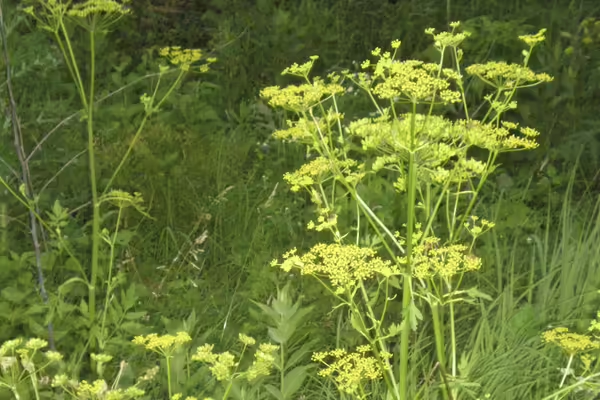
URBANA, Ill. — Often parsnips, large white carrot-like root vegetables, are substituted for celery in soups and stews. The cultivated parsnip that we eat heralds from the appropriately named wild parsnip, Pastinaca sativa. However, wild parsnip is a plant to avoid. The wild version of cultivated parsnip can leave those who encounter it with burn-like blisters on their skin. Severe cases appear somewhat gruesome, though according to some, it is still not as bad as the itch of poison ivy.
Standing next to wild parsnip will not give you burning blisters. A person must make skin contact with the sap of the plant from a broken leaf or stem. The combination of sap on your skin and exposure to UV light causes phytophotodermatitis: an interaction between plants (phyto) and light (photo) that induce skin (derm) inflammation (itis). The effects are a severe sunburn.
Wild parsnip is closely related to Queen Anne's lace and has a similar umbrella-shaped flower, though wild parsnip's flower color is yellow, and it blooms earlier in the summer. Wild parsnip's stem is slightly hairy, grooved, and 2 to 5 feet tall. Leaves are coarse, with saw-toothed edges. Plants can be found throughout Illinois invading prairies, oak savannas, and fens, as well as roadsides, old fields, and pastures.
Since the actual hazard lies in the sap of wild parsnip, exposure can be mitigated by wearing gloves, long pants, and long-sleeved shirts when working outside, in fields, or in overgrown areas that contain this plant. Plan weeding activities for later in the evening during low levels of sunlight to avoid activating the blistering process. Wet sap is required to cause injury. Wild parsnip that has been cut and allowed to dry is safer to handle. Do not wait too long or forget to dispose of cut wild parsnip as seed can develop while the cut plant lays on the ground.
Avoid using string trimmers where you may encounter wild parsnip. The pulverizing, flinging action of string trimmers sprays plant parts and juices everywhere. Operators are often left speckled with blisters and red rashes.
If you are exposed to wild parsnip sap, wash the area that came in contact immediately. If you are too late and begin to feel the burn of wild parsnip sap, contact a physician for wound care recommendations.
Check landscapes periodically for the presence of wild parsnip. Just because it isn't there now, does not mean it won't germinate next week.
Mechanically control wild parsnip by cutting the root 1 to 2 inches below the soil surface. Brush-cutters can be used for large populations before the seed sets. When mowing dense stands of wild parsnip, eye protection and possibly a mask can protect your eyes and lungs. For smaller populations, cut off the flowering heads and dispose in a landfill.
The little rosette of young wild parsnip can be spot treated with broad spectrum or broad-leaf specific herbicides. Contact your local Extension office for recommended active ingredients.
Since parsnip is a biennial, all control activities should be done before it starts flowering or at least during the early flower stage. The basal rosettes can also be controlled in the fall to prevent flowering the next year.
For more research-based information on wild parsnip, connect with your local Illinois Extension county office at go.illinois.edu/ExtensionOffice. Download an infosheet about Wild Parsnip.
Chris Enroth is an Illinois Extension horticulture educator for Henderson, Knox, McDonough, and Warren counties. Gardeners Corner is a quarterly newsletter from gardening experts around the state. Each issue highlights best practices that will make your houseplants, landscape, or garden shine in any season. Join the Gardener’s Corner email list at go.illinois.edu/GCsubscribe for direct access to timely tips.
ABOUT EXTENSION: Illinois Extension leads public outreach for University of Illinois by translating research into action plans that allow Illinois families, businesses, and community leaders to solve problems, make informed decisions, and adapt to changes and opportunities.
PHOTO ACCESS: The photo in this article is available to download for media use.